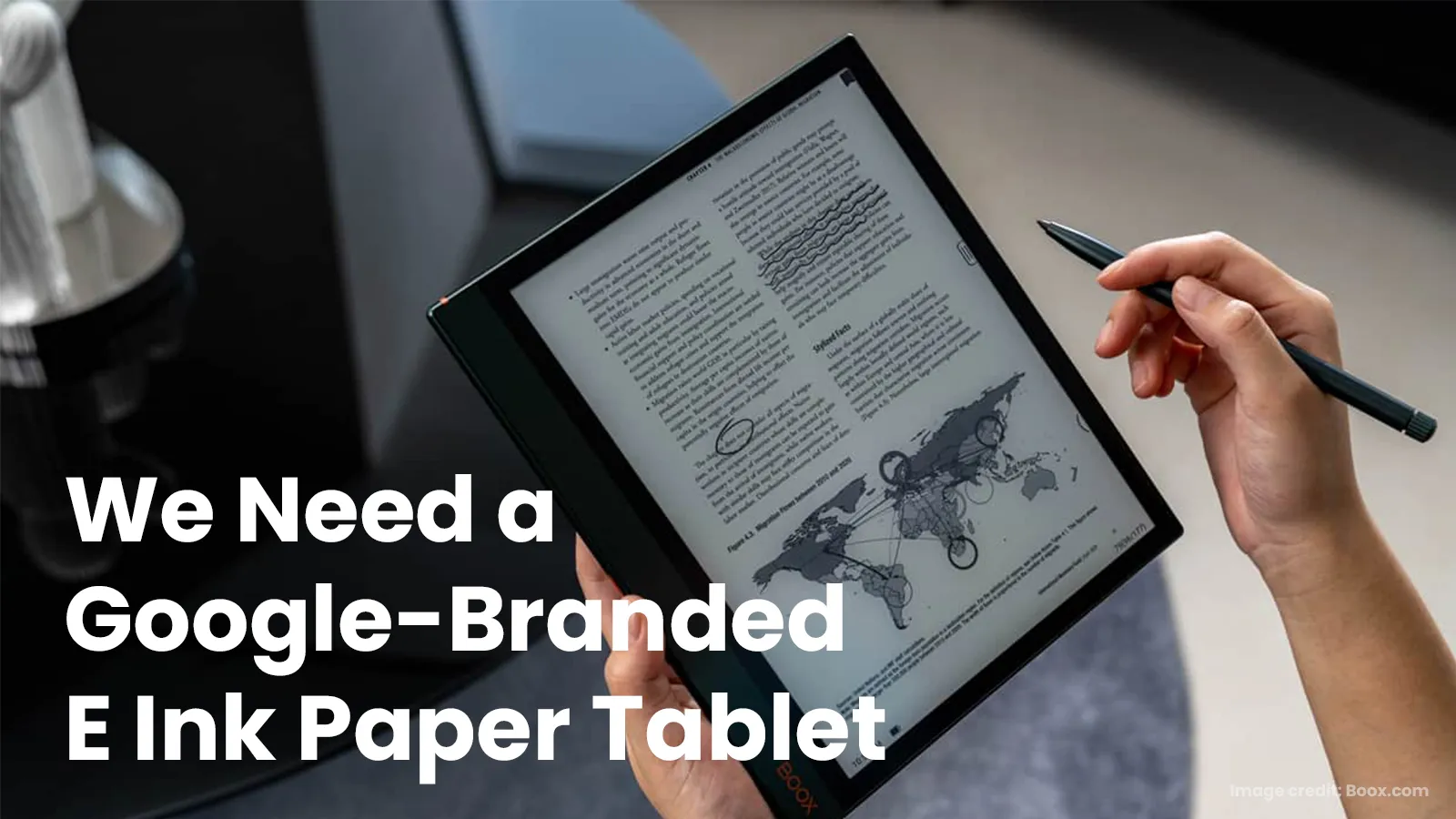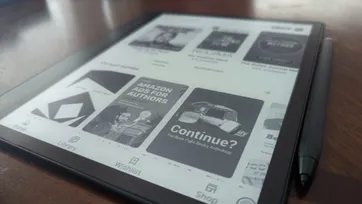Now, more than ever, I want a Google-branded E Ink paper tablet, but it’s unlikely to happen
2022-12-27 / News / 14461 Sees / 0 Comments
Oh boy, where to start? This is a loaded conversation full of many different angles, so let me start from the beginning. As an avid stationary nerd, die-hard Chromebook fan, and self-proclaimed mindfulness expert, I can confidently tell you that there’s a massive gap in the technology landscape for a Google-branded e-Ink paper tablet. Let me explain.
What is E Ink?
If you’re not familiar with e-Ink, it’s a technology that has been popularized by Amazon Kindle devices. You know, the non-LCD screen display that reduces eye strain, has weeks-long battery life, and gives you the sense that you’re actually looking at a piece of paper? The tech itself uses what’s called electronic ink – hence the name – and operates based on tiny capsules under the display that electronically flip one way or another to produce a black or a white spot.
To answer these questions we should start at the very core of e ink technology: small capsules filled with a clear fluid containing teeny-tiny particles, each about as wide as a human hair.
Each electronic paper display is made up of millions of such capsules in a thin film, with the particles inside the capsules of different colors and different electric charges. Electrodes are placed above and below the capsule film. When a positive or negative electric field is applied to an individual electrode, the color particles with the corresponding charge will move either to the top or bottom of a capsule, making the surface of the e-paper display appear a certain color.
Electronic paper explained: what is it and how does it work? – Visionect.com
Seeking out the elusive notetaking unicorn
Most recently, Amazon came out with a device called the Kindle Scribe, which allows for more than just reading ebooks – it also lets you take notes with a stylus! What’s significant about this is that, unlike an LCD tablet or Chromebook, it has perfect palm rejection (something traditional tablets still struggle with to this day) and even feels resistant enough to give a sense that you’re writing on paper.
There are obviously others that have preceded the Scribe, like this new Boox Note Air 2 Plus that I recently ordered, for example. An Android-powered E Ink paper tablet was a better bet for me for a few reasons. First, I was sick of trying to make my Lenovo Chromebook Duet 3 and other Chromebooks in tablet mode work for notetaking. The Duet came the closest for its size, but the much larger and hotter running Samsung Galaxy Chromebook worked perfectly for this use case. The issue was, again, the heat it generated, the hard, metal body, the heft, the tiny stick stylus, and well, I could go on and on.
If I’m taking handwritten notes, something I much prefer to typing as I feel much more connected and free-flowing with my thoughts, these problems are deal breakers. I wanted something under two pounds, ultra-portable, and paper-like that reduced eye strain and didn’t have my running for a charger every few hours. If I’m completely honest, technology has made me more capable yet less connected with my internal thoughts, reflective personality, and attempts at self-actualization. Moving back to paper would afford me the opposite problem which I began with when I started using Chromebooks, so I needed something new.
The perfect device simply does not exist
Having fought with Chromebooks and attempted to wrangle them for handwriting has been a struggle for years, and I nearly came out the victor if it weren’t for the terrible pen and display of the new Duet 3. I lost hope in ChromeOS tablets, and while it’s my experience and not an objective fact that they’re bad, I’ve abandoned ship until further notice. I still use a Chromebook to be productive, but in the planning stages, ideation processes, and alignment times in the morning, I’m now happily using my Boox Note Air 2 Plus.
Despite this, even the Boox is not a perfect device. It’s owned by a Chinese company where questions of privacy and security have risen thanks to the government there. While I know that’s ironic when you consider Google’s track record, I still trust Google over potential national security threats and international spying initiatives.
For this reason, I’ve not enabled synching on my Boox device, and my notes are simply on the device – a dangerous state of existence that I’m not comfortable with as a millennial who’s spent his whole life cloud-synching things as a backup solution.
I desperately want a Google-branded E Ink Paper Tablet
With all of the rambling out of the way, I’ve been getting at the fact that an E Ink paper tablet that runs either ChromeOS or Android, created by Google, that natively integrates Keep, Play Books, Google Cursive, and more would solve all of my problems.
You see, for all of its faults, Cursive – Google’s handwritten notetaking app – is primed for such a thing. It’s more visually appealing, has better organization and tools, and so on than many of its competitors. Even still, it’s simple enough to be the home screen of such a device centered on writing.
Of course, Boox tablets already have Android, but Cursive isn’t available except in read-only mode thanks to its Chromebook-exclusive approach and Keep and other notetaking apps have considerable input lag. We need a device that natively operates on Cursive with Google Play Books on another tab for reading and listening to audiobooks.
Why it would work
While it may sound niche, and well, maybe it truly is, that didn’t stop Amazon from making a paper tablet. I’m actually surprised that Google has yet to jump at this opportunity. E Ink is becoming more affordable (slowly), more widely available, and more mainstream. Not everyone is bought in due to its slow refresh rate, ghosting, and limited use cases, but the desire to use paper to plan and execute on bigger ideas will never go away. Now that I’m in my thirties and over-saturated with keyboards, LCD screens, and apps, I finally get that. You’ll truly only get where I’m coming from when you finally use an E Ink device for yourself!
Do keep in mind as well that Google has been doing a ton of work on its Prosidy model for audiobooks so that they have a much more natural speech pattern, they continue to invest in Play Books and its audience, and the company even archives millions of old newspapers from decades ago. All I’m saying is that Google has a lot of reasons to make such a tablet.
Why it will probably never happen
So then why hasn’t it come about? It’s true that Google is focusing heavily on ChromeOS (again, a ChromeOS base for the E Ink device would rock) so its sights aren’t really set on niche markets, nor can it afford to do so. Add to that the fact that globally, the Google Play Books market share is less than 5% and dropping each year, and the user base for E Ink is still extremely low and imbalanced compared to traditional computers, and it’s clear why there’s no mention of this type of thing coming to market.
As previously mentioned, the refresh rate on paper tablets is also not great, and Google’s apps are made for scrolling. There’s clearly a lot to figure out, but just as with Chromebooks, Google took a chance, stuck it out (for once), and struck gold.
There may yet be hope, but the solution is not black and white
Lastly, the new Pixel Tablet that’s said to double as your next Nest Hub is rumored to be receiving a stylus for handwritten input around the house. If true, I very much doubt that it will fare better than the Lenovo Chromebook Duet for palm rejection, battery life, and eye strain. It is still an LCD display after all, and it’s being created with the mindset that you will never be far from its charging base. It most certainly isn’t a device you’ll be traveling with, but future iterations could succeed where Chromebooks have failed.
With Google adding improved neural input developer flags to ChromeOS over the past few years to help reject your Chromebook’s shelf from activating when your hand touches it, I do believe it’s working hard on these problems. Even still, I hope that one day, we have better solutions that actually work, are reliable, and perhaps even save my poor, aging eyes.
Hell, if we could get a proper handwriting experience on a lightweight Chromebook that simply doesn’t disappoint – something that I’m losing hope with – the battery life on ChromeOS were doubled (yes, I know, that’s an insane request) and a greyscale mode was added to the display, then maybe I would finally find that unicorn device.
Perhaps natively integrating Android’s Digital Wellbeing into ChromeOS would solve this problem and E Ink would no longer be necessary (though I am enjoying it), screen refresh rates would not need to be sacrificed, and the beautiful color that comes with a standard tablet would remain. My hope is that against all odds, Google rushes to fill this gap for those of us who want to be freed from our keyboard-shaped prisons without losing the improvements that the digital age has brought to paper – the original technology for thinkers.
More about“eink,google eink tablet,”'s article.
The original address《Now, more than ever, I want a Google-branded E Ink paper tablet, but it’s unlikely to happen》

